Developing a Pepsi Marketing Plan: Objectives and Strategies
VerifiedAdded on 2023/05/29
|8
|1899
|362
Report
AI Summary
This research project delves into the marketing strategies of PepsiCo, focusing on its brand positioning, marketing objectives, and marketing mix (product, price, place, promotion). The report analyzes Pepsi's points of difference and parity, emphasizing its forward-thinking attitude and product differentiation. It examines the company's objectives, including analyzing customer perception and building a positive brand image. The marketing mix explores Pepsi's product diversification, pricing strategies relative to competitors, extensive distribution network, and promotional activities targeting youth and families. The research also acknowledges the importance of diversification into healthier product lines for sustainable market positioning. Desklib provides access to this and other solved assignments.
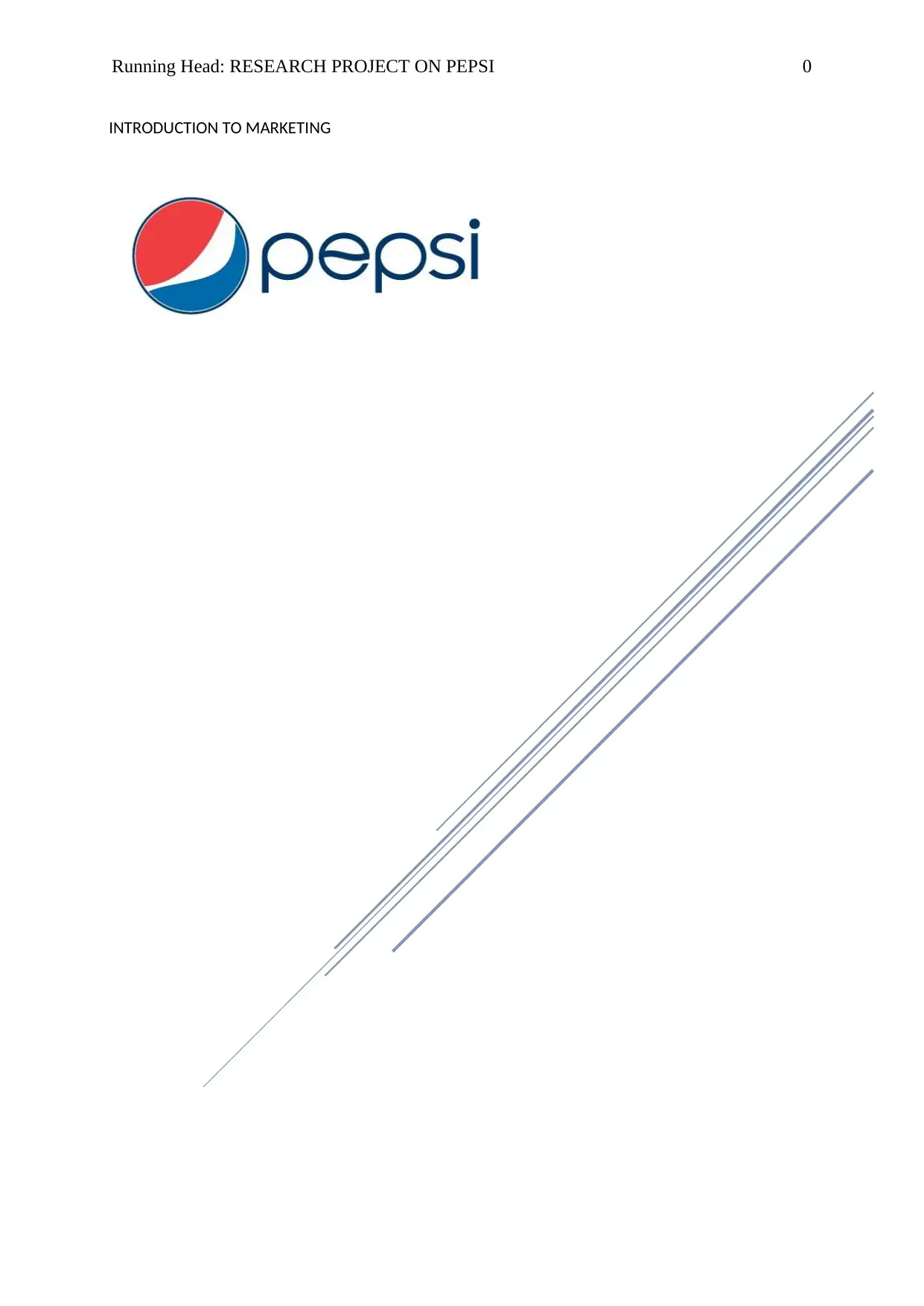
Running Head: RESEARCH PROJECT ON PEPSI 0
INTRODUCTION TO MARKETING
INTRODUCTION TO MARKETING
Paraphrase This Document
Need a fresh take? Get an instant paraphrase of this document with our AI Paraphraser
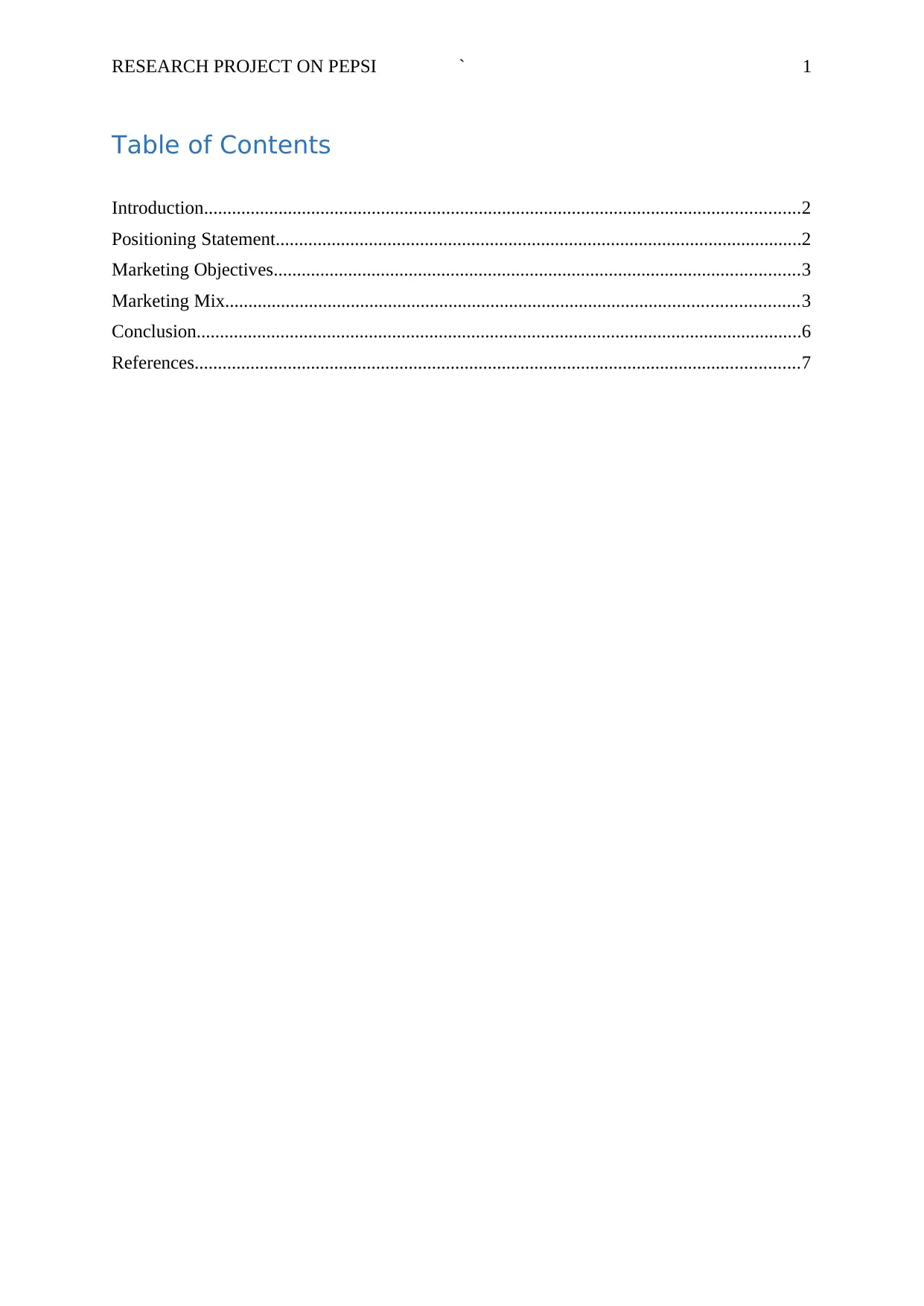
RESEARCH PROJECT ON PEPSI ` 1
Table of Contents
Introduction................................................................................................................................2
Positioning Statement.................................................................................................................2
Marketing Objectives.................................................................................................................3
Marketing Mix...........................................................................................................................3
Conclusion..................................................................................................................................6
References..................................................................................................................................7
Table of Contents
Introduction................................................................................................................................2
Positioning Statement.................................................................................................................2
Marketing Objectives.................................................................................................................3
Marketing Mix...........................................................................................................................3
Conclusion..................................................................................................................................6
References..................................................................................................................................7
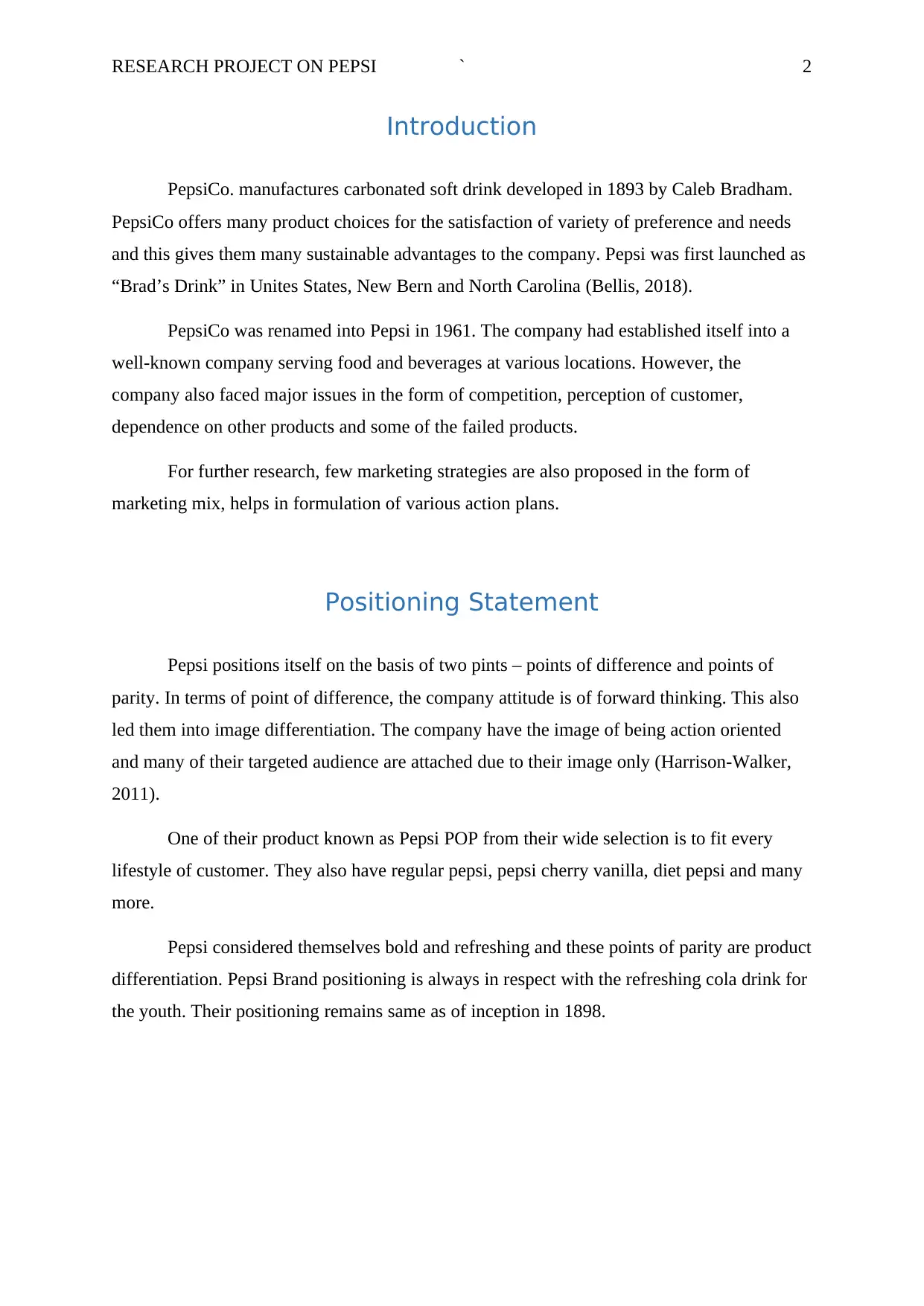
RESEARCH PROJECT ON PEPSI ` 2
Introduction
PepsiCo. manufactures carbonated soft drink developed in 1893 by Caleb Bradham.
PepsiCo offers many product choices for the satisfaction of variety of preference and needs
and this gives them many sustainable advantages to the company. Pepsi was first launched as
“Brad’s Drink” in Unites States, New Bern and North Carolina (Bellis, 2018).
PepsiCo was renamed into Pepsi in 1961. The company had established itself into a
well-known company serving food and beverages at various locations. However, the
company also faced major issues in the form of competition, perception of customer,
dependence on other products and some of the failed products.
For further research, few marketing strategies are also proposed in the form of
marketing mix, helps in formulation of various action plans.
Positioning Statement
Pepsi positions itself on the basis of two pints – points of difference and points of
parity. In terms of point of difference, the company attitude is of forward thinking. This also
led them into image differentiation. The company have the image of being action oriented
and many of their targeted audience are attached due to their image only (Harrison-Walker,
2011).
One of their product known as Pepsi POP from their wide selection is to fit every
lifestyle of customer. They also have regular pepsi, pepsi cherry vanilla, diet pepsi and many
more.
Pepsi considered themselves bold and refreshing and these points of parity are product
differentiation. Pepsi Brand positioning is always in respect with the refreshing cola drink for
the youth. Their positioning remains same as of inception in 1898.
Introduction
PepsiCo. manufactures carbonated soft drink developed in 1893 by Caleb Bradham.
PepsiCo offers many product choices for the satisfaction of variety of preference and needs
and this gives them many sustainable advantages to the company. Pepsi was first launched as
“Brad’s Drink” in Unites States, New Bern and North Carolina (Bellis, 2018).
PepsiCo was renamed into Pepsi in 1961. The company had established itself into a
well-known company serving food and beverages at various locations. However, the
company also faced major issues in the form of competition, perception of customer,
dependence on other products and some of the failed products.
For further research, few marketing strategies are also proposed in the form of
marketing mix, helps in formulation of various action plans.
Positioning Statement
Pepsi positions itself on the basis of two pints – points of difference and points of
parity. In terms of point of difference, the company attitude is of forward thinking. This also
led them into image differentiation. The company have the image of being action oriented
and many of their targeted audience are attached due to their image only (Harrison-Walker,
2011).
One of their product known as Pepsi POP from their wide selection is to fit every
lifestyle of customer. They also have regular pepsi, pepsi cherry vanilla, diet pepsi and many
more.
Pepsi considered themselves bold and refreshing and these points of parity are product
differentiation. Pepsi Brand positioning is always in respect with the refreshing cola drink for
the youth. Their positioning remains same as of inception in 1898.
⊘ This is a preview!⊘
Do you want full access?
Subscribe today to unlock all pages.

Trusted by 1+ million students worldwide
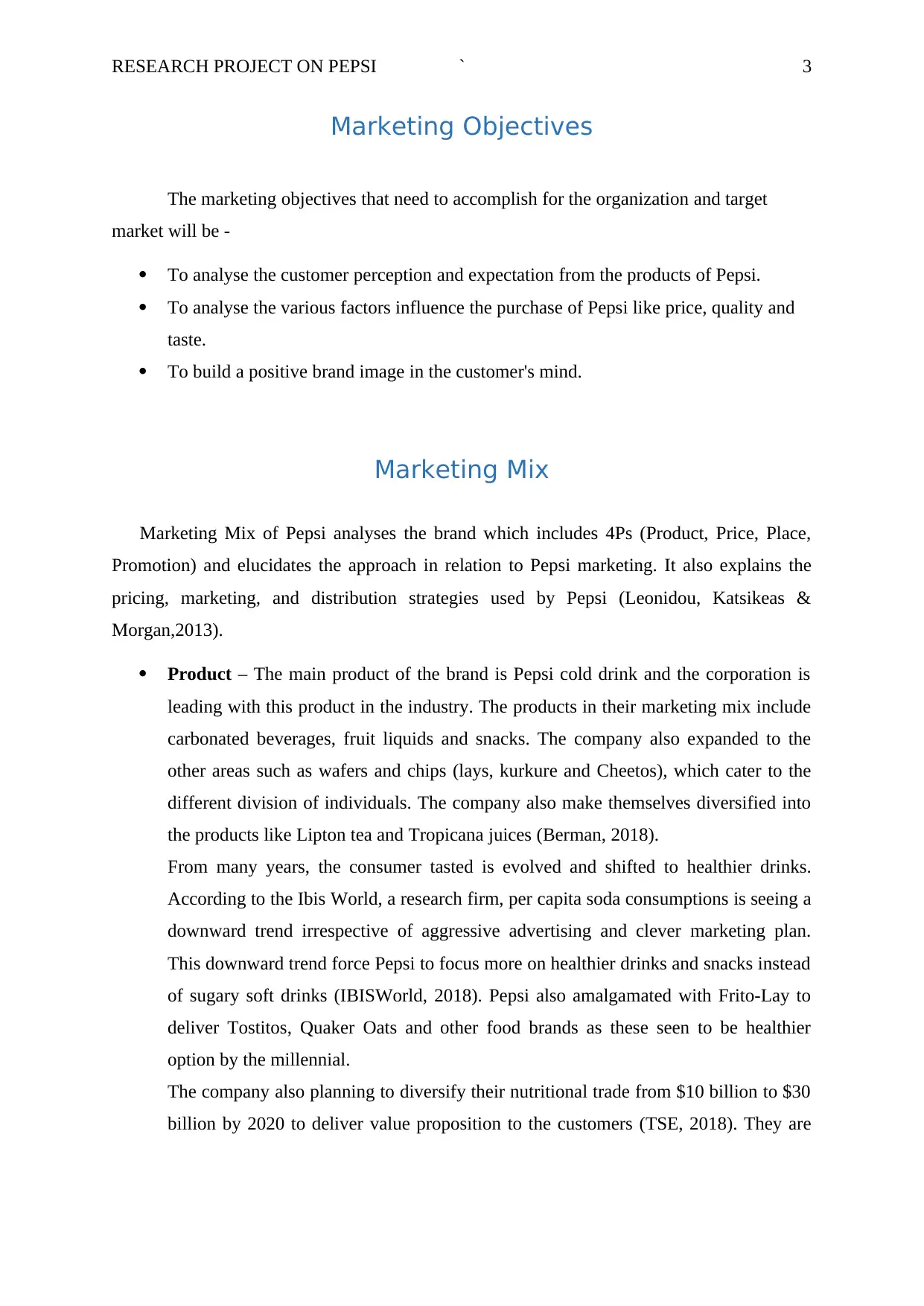
RESEARCH PROJECT ON PEPSI ` 3
Marketing Objectives
The marketing objectives that need to accomplish for the organization and target
market will be -
To analyse the customer perception and expectation from the products of Pepsi.
To analyse the various factors influence the purchase of Pepsi like price, quality and
taste.
To build a positive brand image in the customer's mind.
Marketing Mix
Marketing Mix of Pepsi analyses the brand which includes 4Ps (Product, Price, Place,
Promotion) and elucidates the approach in relation to Pepsi marketing. It also explains the
pricing, marketing, and distribution strategies used by Pepsi (Leonidou, Katsikeas &
Morgan,2013).
Product – The main product of the brand is Pepsi cold drink and the corporation is
leading with this product in the industry. The products in their marketing mix include
carbonated beverages, fruit liquids and snacks. The company also expanded to the
other areas such as wafers and chips (lays, kurkure and Cheetos), which cater to the
different division of individuals. The company also make themselves diversified into
the products like Lipton tea and Tropicana juices (Berman, 2018).
From many years, the consumer tasted is evolved and shifted to healthier drinks.
According to the Ibis World, a research firm, per capita soda consumptions is seeing a
downward trend irrespective of aggressive advertising and clever marketing plan.
This downward trend force Pepsi to focus more on healthier drinks and snacks instead
of sugary soft drinks (IBISWorld, 2018). Pepsi also amalgamated with Frito-Lay to
deliver Tostitos, Quaker Oats and other food brands as these seen to be healthier
option by the millennial.
The company also planning to diversify their nutritional trade from $10 billion to $30
billion by 2020 to deliver value proposition to the customers (TSE, 2018). They are
Marketing Objectives
The marketing objectives that need to accomplish for the organization and target
market will be -
To analyse the customer perception and expectation from the products of Pepsi.
To analyse the various factors influence the purchase of Pepsi like price, quality and
taste.
To build a positive brand image in the customer's mind.
Marketing Mix
Marketing Mix of Pepsi analyses the brand which includes 4Ps (Product, Price, Place,
Promotion) and elucidates the approach in relation to Pepsi marketing. It also explains the
pricing, marketing, and distribution strategies used by Pepsi (Leonidou, Katsikeas &
Morgan,2013).
Product – The main product of the brand is Pepsi cold drink and the corporation is
leading with this product in the industry. The products in their marketing mix include
carbonated beverages, fruit liquids and snacks. The company also expanded to the
other areas such as wafers and chips (lays, kurkure and Cheetos), which cater to the
different division of individuals. The company also make themselves diversified into
the products like Lipton tea and Tropicana juices (Berman, 2018).
From many years, the consumer tasted is evolved and shifted to healthier drinks.
According to the Ibis World, a research firm, per capita soda consumptions is seeing a
downward trend irrespective of aggressive advertising and clever marketing plan.
This downward trend force Pepsi to focus more on healthier drinks and snacks instead
of sugary soft drinks (IBISWorld, 2018). Pepsi also amalgamated with Frito-Lay to
deliver Tostitos, Quaker Oats and other food brands as these seen to be healthier
option by the millennial.
The company also planning to diversify their nutritional trade from $10 billion to $30
billion by 2020 to deliver value proposition to the customers (TSE, 2018). They are
Paraphrase This Document
Need a fresh take? Get an instant paraphrase of this document with our AI Paraphraser
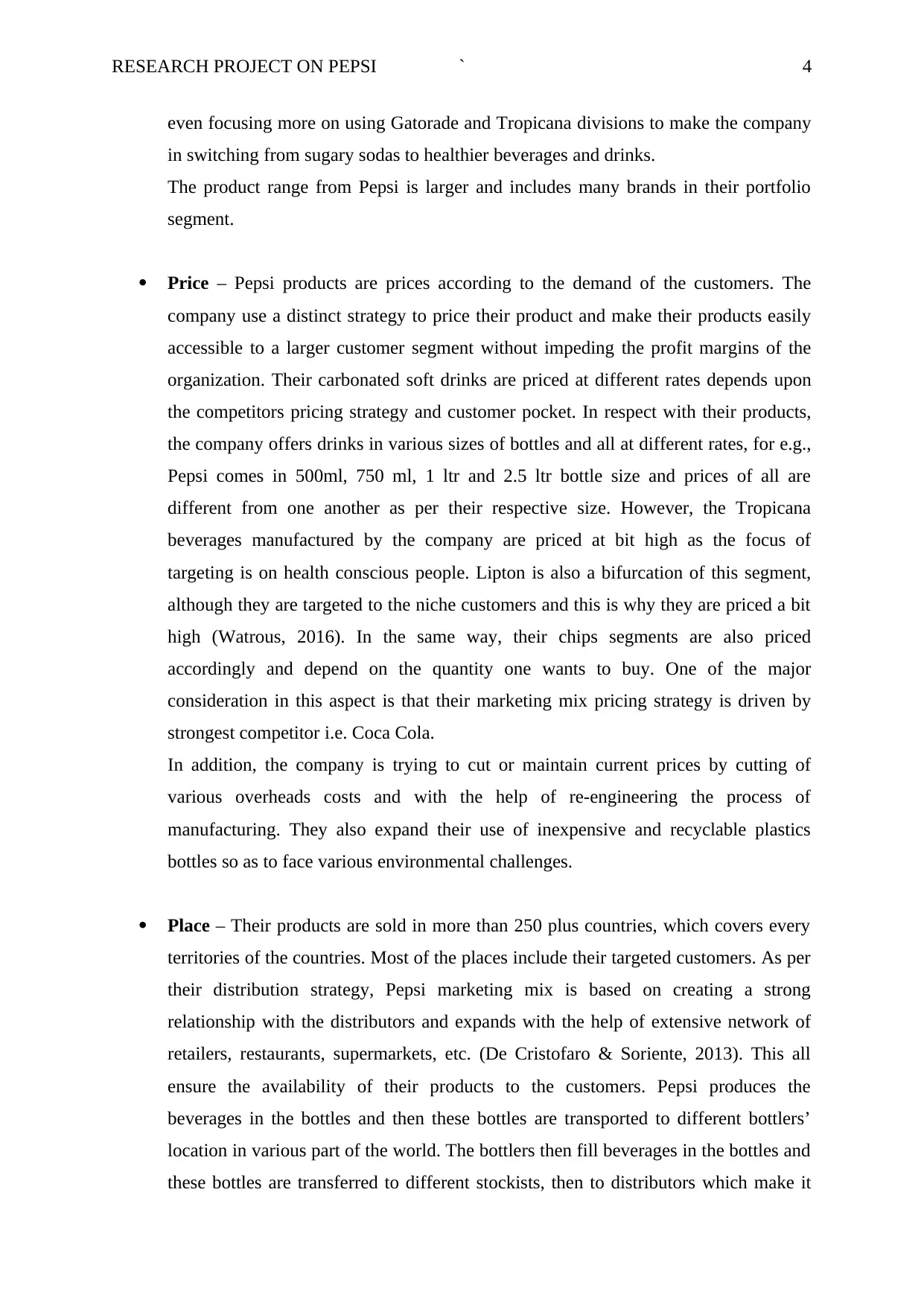
RESEARCH PROJECT ON PEPSI ` 4
even focusing more on using Gatorade and Tropicana divisions to make the company
in switching from sugary sodas to healthier beverages and drinks.
The product range from Pepsi is larger and includes many brands in their portfolio
segment.
Price – Pepsi products are prices according to the demand of the customers. The
company use a distinct strategy to price their product and make their products easily
accessible to a larger customer segment without impeding the profit margins of the
organization. Their carbonated soft drinks are priced at different rates depends upon
the competitors pricing strategy and customer pocket. In respect with their products,
the company offers drinks in various sizes of bottles and all at different rates, for e.g.,
Pepsi comes in 500ml, 750 ml, 1 ltr and 2.5 ltr bottle size and prices of all are
different from one another as per their respective size. However, the Tropicana
beverages manufactured by the company are priced at bit high as the focus of
targeting is on health conscious people. Lipton is also a bifurcation of this segment,
although they are targeted to the niche customers and this is why they are priced a bit
high (Watrous, 2016). In the same way, their chips segments are also priced
accordingly and depend on the quantity one wants to buy. One of the major
consideration in this aspect is that their marketing mix pricing strategy is driven by
strongest competitor i.e. Coca Cola.
In addition, the company is trying to cut or maintain current prices by cutting of
various overheads costs and with the help of re-engineering the process of
manufacturing. They also expand their use of inexpensive and recyclable plastics
bottles so as to face various environmental challenges.
Place – Their products are sold in more than 250 plus countries, which covers every
territories of the countries. Most of the places include their targeted customers. As per
their distribution strategy, Pepsi marketing mix is based on creating a strong
relationship with the distributors and expands with the help of extensive network of
retailers, restaurants, supermarkets, etc. (De Cristofaro & Soriente, 2013). This all
ensure the availability of their products to the customers. Pepsi produces the
beverages in the bottles and then these bottles are transported to different bottlers’
location in various part of the world. The bottlers then fill beverages in the bottles and
these bottles are transferred to different stockists, then to distributors which make it
even focusing more on using Gatorade and Tropicana divisions to make the company
in switching from sugary sodas to healthier beverages and drinks.
The product range from Pepsi is larger and includes many brands in their portfolio
segment.
Price – Pepsi products are prices according to the demand of the customers. The
company use a distinct strategy to price their product and make their products easily
accessible to a larger customer segment without impeding the profit margins of the
organization. Their carbonated soft drinks are priced at different rates depends upon
the competitors pricing strategy and customer pocket. In respect with their products,
the company offers drinks in various sizes of bottles and all at different rates, for e.g.,
Pepsi comes in 500ml, 750 ml, 1 ltr and 2.5 ltr bottle size and prices of all are
different from one another as per their respective size. However, the Tropicana
beverages manufactured by the company are priced at bit high as the focus of
targeting is on health conscious people. Lipton is also a bifurcation of this segment,
although they are targeted to the niche customers and this is why they are priced a bit
high (Watrous, 2016). In the same way, their chips segments are also priced
accordingly and depend on the quantity one wants to buy. One of the major
consideration in this aspect is that their marketing mix pricing strategy is driven by
strongest competitor i.e. Coca Cola.
In addition, the company is trying to cut or maintain current prices by cutting of
various overheads costs and with the help of re-engineering the process of
manufacturing. They also expand their use of inexpensive and recyclable plastics
bottles so as to face various environmental challenges.
Place – Their products are sold in more than 250 plus countries, which covers every
territories of the countries. Most of the places include their targeted customers. As per
their distribution strategy, Pepsi marketing mix is based on creating a strong
relationship with the distributors and expands with the help of extensive network of
retailers, restaurants, supermarkets, etc. (De Cristofaro & Soriente, 2013). This all
ensure the availability of their products to the customers. Pepsi produces the
beverages in the bottles and then these bottles are transported to different bottlers’
location in various part of the world. The bottlers then fill beverages in the bottles and
these bottles are transferred to different stockists, then to distributors which make it
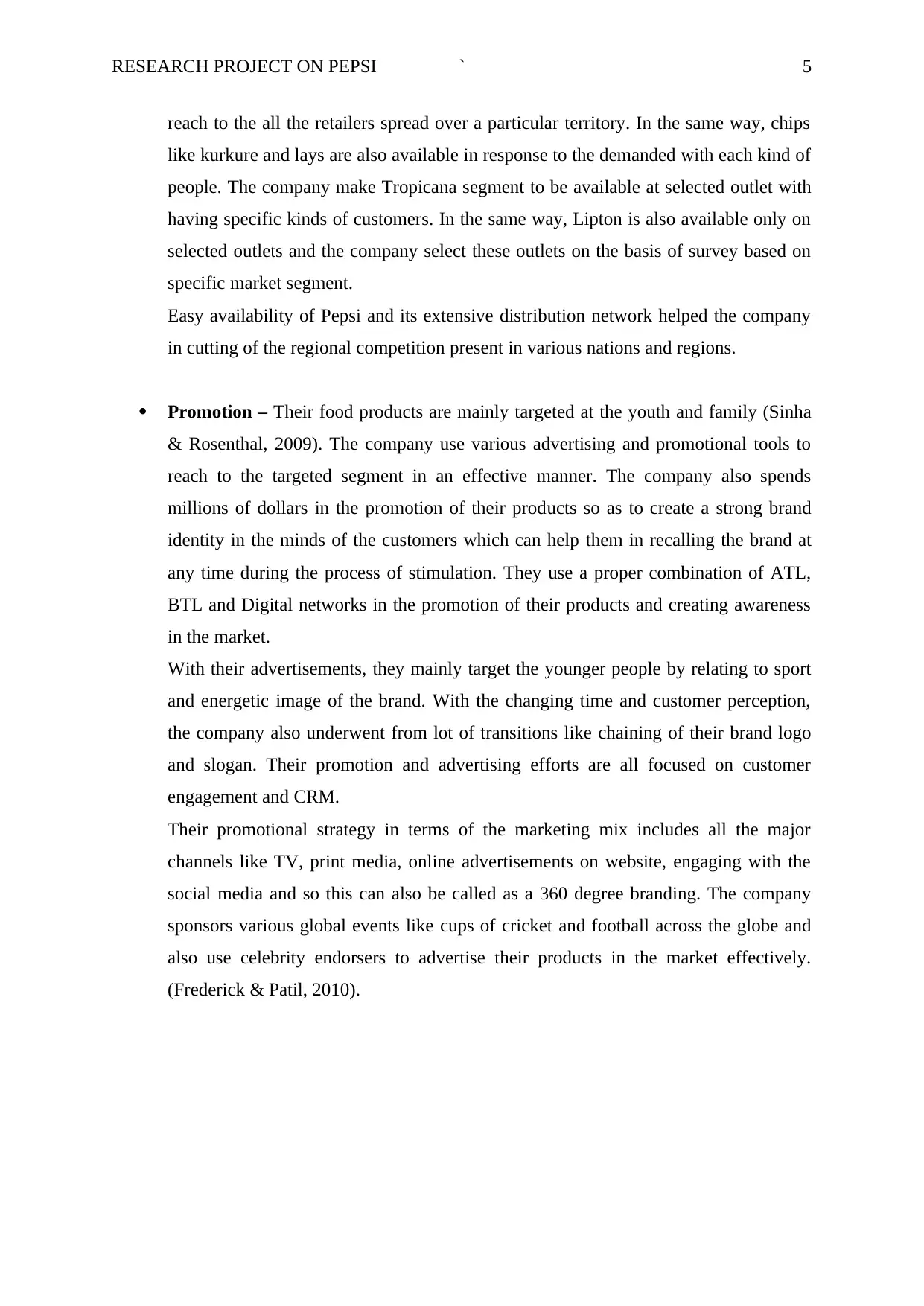
RESEARCH PROJECT ON PEPSI ` 5
reach to the all the retailers spread over a particular territory. In the same way, chips
like kurkure and lays are also available in response to the demanded with each kind of
people. The company make Tropicana segment to be available at selected outlet with
having specific kinds of customers. In the same way, Lipton is also available only on
selected outlets and the company select these outlets on the basis of survey based on
specific market segment.
Easy availability of Pepsi and its extensive distribution network helped the company
in cutting of the regional competition present in various nations and regions.
Promotion – Their food products are mainly targeted at the youth and family (Sinha
& Rosenthal, 2009). The company use various advertising and promotional tools to
reach to the targeted segment in an effective manner. The company also spends
millions of dollars in the promotion of their products so as to create a strong brand
identity in the minds of the customers which can help them in recalling the brand at
any time during the process of stimulation. They use a proper combination of ATL,
BTL and Digital networks in the promotion of their products and creating awareness
in the market.
With their advertisements, they mainly target the younger people by relating to sport
and energetic image of the brand. With the changing time and customer perception,
the company also underwent from lot of transitions like chaining of their brand logo
and slogan. Their promotion and advertising efforts are all focused on customer
engagement and CRM.
Their promotional strategy in terms of the marketing mix includes all the major
channels like TV, print media, online advertisements on website, engaging with the
social media and so this can also be called as a 360 degree branding. The company
sponsors various global events like cups of cricket and football across the globe and
also use celebrity endorsers to advertise their products in the market effectively.
(Frederick & Patil, 2010).
reach to the all the retailers spread over a particular territory. In the same way, chips
like kurkure and lays are also available in response to the demanded with each kind of
people. The company make Tropicana segment to be available at selected outlet with
having specific kinds of customers. In the same way, Lipton is also available only on
selected outlets and the company select these outlets on the basis of survey based on
specific market segment.
Easy availability of Pepsi and its extensive distribution network helped the company
in cutting of the regional competition present in various nations and regions.
Promotion – Their food products are mainly targeted at the youth and family (Sinha
& Rosenthal, 2009). The company use various advertising and promotional tools to
reach to the targeted segment in an effective manner. The company also spends
millions of dollars in the promotion of their products so as to create a strong brand
identity in the minds of the customers which can help them in recalling the brand at
any time during the process of stimulation. They use a proper combination of ATL,
BTL and Digital networks in the promotion of their products and creating awareness
in the market.
With their advertisements, they mainly target the younger people by relating to sport
and energetic image of the brand. With the changing time and customer perception,
the company also underwent from lot of transitions like chaining of their brand logo
and slogan. Their promotion and advertising efforts are all focused on customer
engagement and CRM.
Their promotional strategy in terms of the marketing mix includes all the major
channels like TV, print media, online advertisements on website, engaging with the
social media and so this can also be called as a 360 degree branding. The company
sponsors various global events like cups of cricket and football across the globe and
also use celebrity endorsers to advertise their products in the market effectively.
(Frederick & Patil, 2010).
⊘ This is a preview!⊘
Do you want full access?
Subscribe today to unlock all pages.

Trusted by 1+ million students worldwide
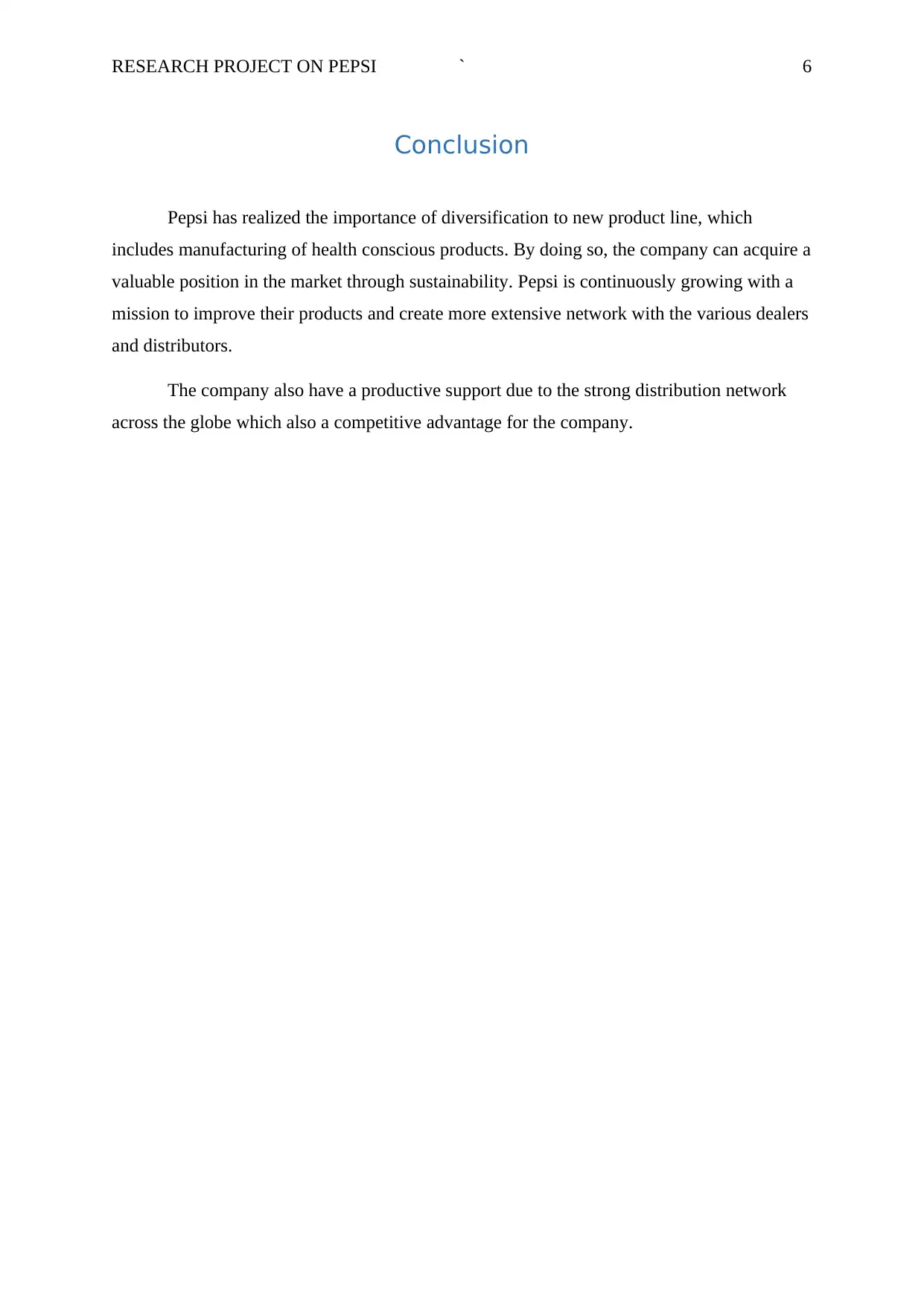
RESEARCH PROJECT ON PEPSI ` 6
Conclusion
Pepsi has realized the importance of diversification to new product line, which
includes manufacturing of health conscious products. By doing so, the company can acquire a
valuable position in the market through sustainability. Pepsi is continuously growing with a
mission to improve their products and create more extensive network with the various dealers
and distributors.
The company also have a productive support due to the strong distribution network
across the globe which also a competitive advantage for the company.
Conclusion
Pepsi has realized the importance of diversification to new product line, which
includes manufacturing of health conscious products. By doing so, the company can acquire a
valuable position in the market through sustainability. Pepsi is continuously growing with a
mission to improve their products and create more extensive network with the various dealers
and distributors.
The company also have a productive support due to the strong distribution network
across the globe which also a competitive advantage for the company.
Paraphrase This Document
Need a fresh take? Get an instant paraphrase of this document with our AI Paraphraser
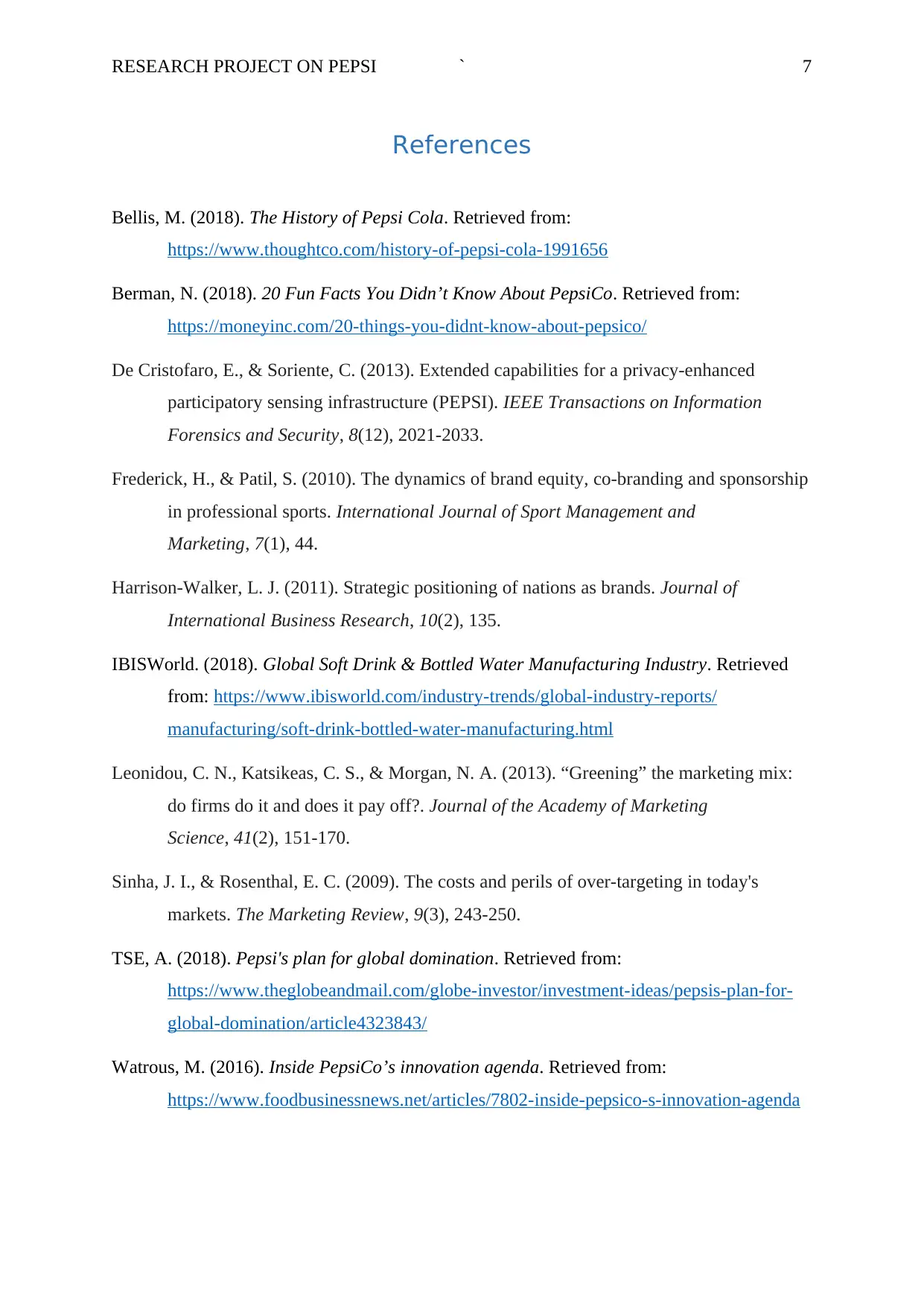
RESEARCH PROJECT ON PEPSI ` 7
References
Bellis, M. (2018). The History of Pepsi Cola. Retrieved from:
https://www.thoughtco.com/history-of-pepsi-cola-1991656
Berman, N. (2018). 20 Fun Facts You Didn’t Know About PepsiCo. Retrieved from:
https://moneyinc.com/20-things-you-didnt-know-about-pepsico/
De Cristofaro, E., & Soriente, C. (2013). Extended capabilities for a privacy-enhanced
participatory sensing infrastructure (PEPSI). IEEE Transactions on Information
Forensics and Security, 8(12), 2021-2033.
Frederick, H., & Patil, S. (2010). The dynamics of brand equity, co-branding and sponsorship
in professional sports. International Journal of Sport Management and
Marketing, 7(1), 44.
Harrison-Walker, L. J. (2011). Strategic positioning of nations as brands. Journal of
International Business Research, 10(2), 135.
IBISWorld. (2018). Global Soft Drink & Bottled Water Manufacturing Industry. Retrieved
from: https://www.ibisworld.com/industry-trends/global-industry-reports/
manufacturing/soft-drink-bottled-water-manufacturing.html
Leonidou, C. N., Katsikeas, C. S., & Morgan, N. A. (2013). “Greening” the marketing mix:
do firms do it and does it pay off?. Journal of the Academy of Marketing
Science, 41(2), 151-170.
Sinha, J. I., & Rosenthal, E. C. (2009). The costs and perils of over-targeting in today's
markets. The Marketing Review, 9(3), 243-250.
TSE, A. (2018). Pepsi's plan for global domination. Retrieved from:
https://www.theglobeandmail.com/globe-investor/investment-ideas/pepsis-plan-for-
global-domination/article4323843/
Watrous, M. (2016). Inside PepsiCo’s innovation agenda. Retrieved from:
https://www.foodbusinessnews.net/articles/7802-inside-pepsico-s-innovation-agenda
References
Bellis, M. (2018). The History of Pepsi Cola. Retrieved from:
https://www.thoughtco.com/history-of-pepsi-cola-1991656
Berman, N. (2018). 20 Fun Facts You Didn’t Know About PepsiCo. Retrieved from:
https://moneyinc.com/20-things-you-didnt-know-about-pepsico/
De Cristofaro, E., & Soriente, C. (2013). Extended capabilities for a privacy-enhanced
participatory sensing infrastructure (PEPSI). IEEE Transactions on Information
Forensics and Security, 8(12), 2021-2033.
Frederick, H., & Patil, S. (2010). The dynamics of brand equity, co-branding and sponsorship
in professional sports. International Journal of Sport Management and
Marketing, 7(1), 44.
Harrison-Walker, L. J. (2011). Strategic positioning of nations as brands. Journal of
International Business Research, 10(2), 135.
IBISWorld. (2018). Global Soft Drink & Bottled Water Manufacturing Industry. Retrieved
from: https://www.ibisworld.com/industry-trends/global-industry-reports/
manufacturing/soft-drink-bottled-water-manufacturing.html
Leonidou, C. N., Katsikeas, C. S., & Morgan, N. A. (2013). “Greening” the marketing mix:
do firms do it and does it pay off?. Journal of the Academy of Marketing
Science, 41(2), 151-170.
Sinha, J. I., & Rosenthal, E. C. (2009). The costs and perils of over-targeting in today's
markets. The Marketing Review, 9(3), 243-250.
TSE, A. (2018). Pepsi's plan for global domination. Retrieved from:
https://www.theglobeandmail.com/globe-investor/investment-ideas/pepsis-plan-for-
global-domination/article4323843/
Watrous, M. (2016). Inside PepsiCo’s innovation agenda. Retrieved from:
https://www.foodbusinessnews.net/articles/7802-inside-pepsico-s-innovation-agenda
1 out of 8
Related Documents
Your All-in-One AI-Powered Toolkit for Academic Success.
+13062052269
info@desklib.com
Available 24*7 on WhatsApp / Email
![[object Object]](/_next/static/media/star-bottom.7253800d.svg)
Unlock your academic potential
Copyright © 2020–2025 A2Z Services. All Rights Reserved. Developed and managed by ZUCOL.





